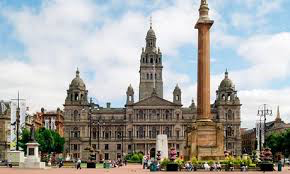There's Gold in Them There Stars
The BBC's science editor Pallab Ghosh provides an excellent summary of the huge excitement surrounding the collision of two massively heavy neutron stars in far-off deep space.
Einstein’s waves detected in star smash
By Pallab Ghosh - BBC News
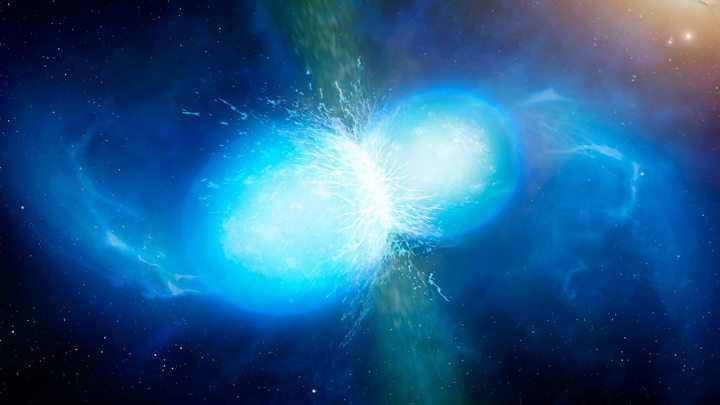
Media caption - Scientists can convert the gravitational wave signal into sound
Scientists have detected the warping of space generated by the collision of two dead stars, or neutron stars.
They have confirmed that such mergers lead to the production of the gold and platinum that exists in the Universe.
The measurement of the gravitational waves given off by this cataclysmic event was made on 17 August by the LIGO-VIRGO Collaboration.
The discovery enabled telescopes all over the world to capture details of the merger as it unfolded.
David Reitze, executive director of the LIGO Laboratory at Caltech in Pasadena, California, said: "This is the one we've all been waiting for."
Einstein's waves win physics Nobel
Gravitational waves quest to go into space
Getting your head around Einstein's waves
Gravitational waves: A triumph for big science
The outburst took place in a galaxy called NGC 4993, located roughly a thousand billion, billion km away in the Constellation Hydra.
It happened 130 million years ago - when dinosaurs roamed the Earth. It was so far away that the light and gravitational waves have only just reached us.
The stars themselves had masses 10-20% greater than our Sun - but they were no larger than 30km across.
They were the crushed leftover cores of massive stars that long ago exploded as supernovas.
They are called neutron stars because the process of crushing the star makes the charged protons and electrons in the atoms of the star combine - to form an object made entirely of neutrons.
Such remnants are incredibly dense - a teaspoonful would weigh a billion tonnes.
In the landscaped campus of one of the laboratories that made the detection, a fountain sprays jets of water skyward which are then pulled back down by gravity, sending ripples across the crystal clear pond.
The LIGO detector, sitting incongruously in the vast woodland of Livingston in Louisiana, was designed to detect the gravitational ripples across the Universe created by cataclysmic cosmic events.
Since it was upgraded two years ago, it has four times sensed the collisions of black holes.
Gravitational waves caused by violent events send ripples through space-time that stretch and squeeze everything they pass through by a tiny amount - less than the width of an atom.
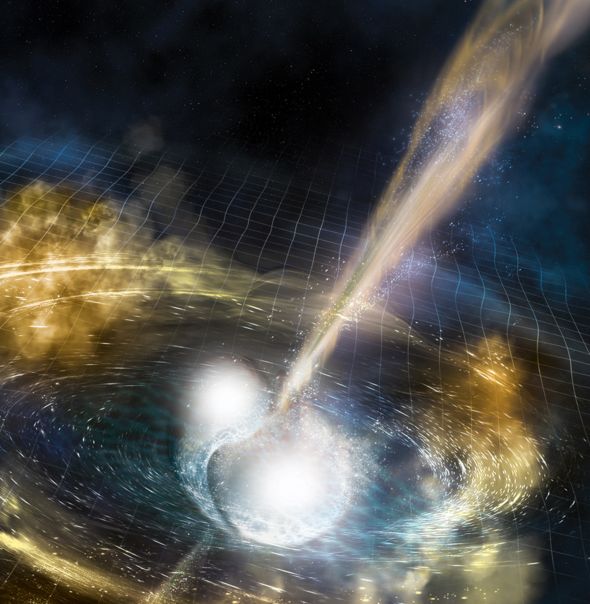
Image copyright - NSF/LIGO/SONOMA STATE UNIVERSITY/A.SIMONNET Image caption Artwork: Merging neutron stars rippling across space-time
The LIGO lab at Livingston consists of a small building with two, two-and-a-half-mile pipelines stretching out at right angles. Inside each pipe is a powerful laser accurately measuring any change in its length.
I walk along one of the pipes with Prof Norna Robertson, a Scot who used to work at Glasgow University - and more recently helped to design the instrument's detection system.
Prof Robertson's work has helped the LIGO-VIRGO Scientific Collaboration to make the first ever detection of the gravitational waves given off by the collision of two neutron stars.
"I'm really thrilled about what we have done. I started off as a student in Glasgow 40 years ago working on gravitational waves. It's been a long long road; there have been some ups and downs but now it's all come together," she told BBC News.
"These last couple of years, first of all with the detection of black holes mergers and now a neutron star merger, I really feel we are opening up a new field, and that's what I wanted to do and now we've done it."
The detection enabled 70 telescopes to obtain the first ever detailed pictures of such an event.
These show an explosion 1,000 times more powerful than a supernova - a burst called a kilonova.
Gravitational waves - Ripples in the fabric of space-time
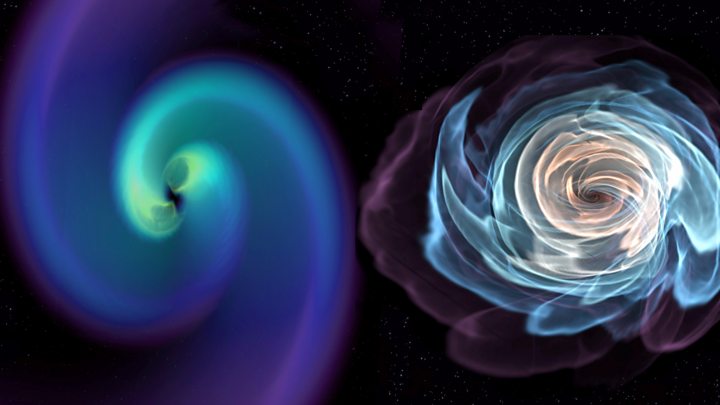
Media caption - A visualisation shows the coalescence of two orbiting neutron stars
The LIGO lab at Livingston consists of a small building with two, two-and-a-half-mile pipelines stretching out at right angles. Inside each pipe is a powerful laser accurately measuring any change in its length.
I walk along one of the pipes with Prof Norna Robertson, a Scot who used to work at Glasgow University - and more recently helped to design the instrument's detection system.
Prof Robertson's work has helped the LIGO-VIRGO Scientific Collaboration to make the first ever detection of the gravitational waves given off by the collision of two neutron stars.
"I'm really thrilled about what we have done. I started off as a student in Glasgow 40 years ago working on gravitational waves. It's been a long long road; there have been some ups and downs but now it's all come together," she told BBC News.
"These last couple of years, first of all with the detection of black holes mergers and now a neutron star merger, I really feel we are opening up a new field, and that's what I wanted to do and now we've done it."
The detection enabled 70 telescopes to obtain the first ever detailed pictures of such an event.
These show an explosion 1,000 times more powerful than a supernova - a burst called a kilonova.
Gravitational waves - Ripples in the fabric of space-time

Media caption - A visualisation shows the coalescence of two orbiting neutron stars
- Gravitational waves are a prediction of the Theory of General Relativity
- It took decades to develop the technology to directly detect them
- They are ripples in the fabric of space-time generated by violent events
- Accelerating masses will produce waves that propagate at the speed of light
- Detectable sources ought to include merging black holes and neutron stars
- Ligo/Virgo fire lasers into long, L-shaped tunnels; the waves disturb the light
- Detecting the waves opens up the Universe to completely new investigations
Dr Kate Maguire, from Queen's University Belfast, who analysed the collision's burst of light, said that the theory was now proven.
"Using some of the world's best telescopes, we have discovered that this neutron star merger scattered heavy chemical elements, such as gold and platinum, out into space at high speeds.
"These new results have significantly contributed to solving the long-debated mystery of the origin of elements heavier than iron in the periodic table."
Dr Joe Lyman, of the University of Warwick said described the observations as "exquisite".
"They tell us that the heavy elements, like the gold or platinum in jewellery are the cinders, forged in the billion degree remnants of a merging neutron star."
Improvements coming
It was also direct confirmation that short bursts of gamma-ray radiation are linked to colliding neutron stars.
By combining information from gravitational waves and the light collected by telescopes, researchers also used a new technique to measure the expansion rate of the Universe. This technique was first proposed in 1986 by the University of Cardiff's Prof Bernard Schutz.
Prof Stephen Hawking of Cambridge University told BBC News that this was "the first rung of a ladder" for a new method of measuring distances in the Universe.
"A new observational window on the Universe typically leads to surprises that cannot yet be foreseen. We are still rubbing our eyes, or rather ears, as we have just woken up to the sound of gravitational waves," he said.
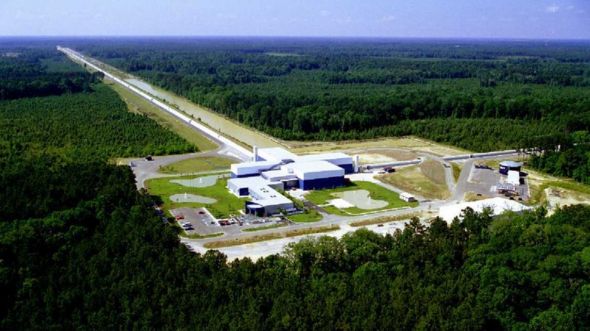
Image copyright - NSF Image caption - The LIGO Louisiana lab has 4km-long pipes running out from its control centre
Prof Nial Tanvir, from Leicester University, uses the VISTA telescope in Chile.
He and his colleagues started searching for the neutron star collision as soon as they heard of the gravitational wave detection.
"We were really excited when we first got notification that a neutron star merger had been detected by LIGO," he said. "We stayed up all night analysing the images as they came in, and it was remarkable how well the observations matched the theoretical predictions that had been made."
LIGO is now being upgraded. In a year's time it will be twice as sensitive - and so will be able to scan eight times the volume of the space.
The researchers believe that detections of black holes and neutron stars will become common place. And they hope that they will begin to detect objects that they currently cannot even imagine and so usher in a new era of astronomy.
The Guardian carried a great piece yesterday on the two massively dense neutron stars which collided in space 130 million years ago, at a time when dinosaurs still roamed the earth.
It's event like this that remind me why I'm not a religious person or a believer in holy books which insist that a Supreme Being for some reason created our tiny planet, the 'third rock' from the Sun, as the centrepiece of an unbelievably massive universe.
If you ask me, the singer songwriter Joni Mitchel was nearer the mark when she wrote the words of her famous song Woodstock in which she said:
"We are stardust, we are golden"
Not least because science has at long last proved that heavy elements from the Periodic Table including 'Gold' were created in the furnaces of these fascinating, far off stars before landing on distant planets and being dug out of the ground by human beings many millions of years later.
Which is why I think that Darwinian evolution, the fossil record and the exploration of science are so much more interesting that the fanciful tales contained in the Bible, Quran and so on.
https://www.theguardian.com/science/2017/oct/16/astronomers-witness-neutron-stars-collide-global-rapid-response-event-ligo
New frontier for science as astronomers witness neutron stars colliding
Extraordinary event has been ‘seen’ for the first time, in both gravitational waves and light – ending decades-old debate about where gold comes from
By Hannah Devlin - The Guardian
The collision of a pair of neutron stars, marked by ripples through the fabric of space-time and a flash brighter than a billion suns, has been witnessed for the first time in the most intensely observed astronomical event to date.
The extraordinary sequence, in which the two ultra-dense stars spiralled inwards, violently collided and, in all likelihood, immediately collapsed into a black hole, was first picked up by the US-based Laser Interferometer Gravitational-Wave Observatory (Ligo).
As its twin detectors, in Louisiana and Washington state, picked up tremors in space-time that had spilled out from the merger 130m light years away, an alert went out to astronomers across the globe. Within hours, 70 space- and ground-based telescopes swivelled to observe the red-tinged afterglow, making it the first cosmic event to be “seen” in both gravitational waves and light.
Shoemaker was alerted by a ringtone on his phone reserved for when black holes or neutron stars collide
Dave Reitze, executive director of Ligo, said: “What is amazing about this discovery is it is the first time we’ve got a full picture of one of the most violent, cataclysmic events in the universe. This is the most intense observational campaign there has ever been.”
Einstein first predicted the existence of gravitational waves a century ago, but the first experimental proof that space itself can be stretched and squeezed took until 2015, when Ligo scientists detected a collision of black holes. But this dark merger, and the three detected since, were invisible to conventional telescopes.
This time, as the stars collided, they emitted an intense beam of gamma rays and the sky was showered with heavy elements, resolving a decades-old debate about where gold and platinum come from.
The 100-second hum picked up by Ligo told the story of how the two stars, each slightly heavier than the sun, approached their death. Initially separated by 200 miles, they circled each other 30 times a second. As they whirled inwards, accelerating to 2,000 orbits each second, the signal rose in pitch like a slide whistle.
Two seconds later, Nasa’s Fermi space telescope picked up an intense burst of gamma rays, emitted as shockwaves rushed through jets of matter funnelled out of the poles during the monumental impact of the collision.
This animation captures phenomena observed over nine days following the neutron star merger known as GW170817.
What happened next is uncertain. A neutron star weighing more than twice the mass of the sun (the combined mass here) has never been seen before – but neither has a black hole so small. Theoretical predictions suggest an almost instantaneous gravitational collapse into a black hole is most likely.
“Neutron stars are at this sweet spot between a star and a black hole,” said Prof Andreas Freise, a Ligo project scientist at the University of Birmingham. “When two of them collide, we expect them to immediately collapse into a black hole, leaving behind a bit of dust and stuff.”
David Shoemaker, spokesman for the Ligo Scientific Collaboration, said: “It’s [probably] the first observation of a black hole being created where there was none before, which is pretty darn cool.”
Prof Nial Tanvir, from Leicester University, uses the VISTA telescope in Chile.
He and his colleagues started searching for the neutron star collision as soon as they heard of the gravitational wave detection.
"We were really excited when we first got notification that a neutron star merger had been detected by LIGO," he said. "We stayed up all night analysing the images as they came in, and it was remarkable how well the observations matched the theoretical predictions that had been made."
LIGO is now being upgraded. In a year's time it will be twice as sensitive - and so will be able to scan eight times the volume of the space.
The researchers believe that detections of black holes and neutron stars will become common place. And they hope that they will begin to detect objects that they currently cannot even imagine and so usher in a new era of astronomy.
Stardust and Golden (18/10/17)
The Guardian carried a great piece yesterday on the two massively dense neutron stars which collided in space 130 million years ago, at a time when dinosaurs still roamed the earth.
It's event like this that remind me why I'm not a religious person or a believer in holy books which insist that a Supreme Being for some reason created our tiny planet, the 'third rock' from the Sun, as the centrepiece of an unbelievably massive universe.
If you ask me, the singer songwriter Joni Mitchel was nearer the mark when she wrote the words of her famous song Woodstock in which she said:
"We are stardust, we are golden"
Not least because science has at long last proved that heavy elements from the Periodic Table including 'Gold' were created in the furnaces of these fascinating, far off stars before landing on distant planets and being dug out of the ground by human beings many millions of years later.
Which is why I think that Darwinian evolution, the fossil record and the exploration of science are so much more interesting that the fanciful tales contained in the Bible, Quran and so on.
https://www.theguardian.com/science/2017/oct/16/astronomers-witness-neutron-stars-collide-global-rapid-response-event-ligo
New frontier for science as astronomers witness neutron stars colliding
Extraordinary event has been ‘seen’ for the first time, in both gravitational waves and light – ending decades-old debate about where gold comes from
By Hannah Devlin - The Guardian
The collision of a pair of neutron stars, marked by ripples through the fabric of space-time and a flash brighter than a billion suns, has been witnessed for the first time in the most intensely observed astronomical event to date.
The extraordinary sequence, in which the two ultra-dense stars spiralled inwards, violently collided and, in all likelihood, immediately collapsed into a black hole, was first picked up by the US-based Laser Interferometer Gravitational-Wave Observatory (Ligo).
As its twin detectors, in Louisiana and Washington state, picked up tremors in space-time that had spilled out from the merger 130m light years away, an alert went out to astronomers across the globe. Within hours, 70 space- and ground-based telescopes swivelled to observe the red-tinged afterglow, making it the first cosmic event to be “seen” in both gravitational waves and light.
Shoemaker was alerted by a ringtone on his phone reserved for when black holes or neutron stars collide
Dave Reitze, executive director of Ligo, said: “What is amazing about this discovery is it is the first time we’ve got a full picture of one of the most violent, cataclysmic events in the universe. This is the most intense observational campaign there has ever been.”
Einstein first predicted the existence of gravitational waves a century ago, but the first experimental proof that space itself can be stretched and squeezed took until 2015, when Ligo scientists detected a collision of black holes. But this dark merger, and the three detected since, were invisible to conventional telescopes.
This time, as the stars collided, they emitted an intense beam of gamma rays and the sky was showered with heavy elements, resolving a decades-old debate about where gold and platinum come from.
When neutron stars collide
1. Gravitational waves are detected
2. 100 seconds later
Now orbiting at 2,000 times per second and on the brink of colliding, the stars are being distorted by intense gravity
Two neutron stars orbit each other 30 times per second, distorting space and time
Only about 12 miles across, each star is more massive than the sun
3. Two seconds later
4. Afterglow
After the briefest pause, where Ligo could detect nothing, the stars violently merge, emitting a burst of gamma rays
Scientists spot a new light in the sky, the afterglow of the collision, which they are able to identify as the source of the gravitational waves and gamma ray burst
The neutron stars probably collapsed into a black hole
Spectrometers detect heavy elements such as silver and gold
Neutron stars are the smallest, densest stars known to exist: about 12 miles wide, with a teaspoon of neutron star material having a mass of about a billion tons. The core is a soup of pure neutrons, while the crust is smooth, solid and 10 billion times stronger than steel.
The 100-second hum picked up by Ligo told the story of how the two stars, each slightly heavier than the sun, approached their death. Initially separated by 200 miles, they circled each other 30 times a second. As they whirled inwards, accelerating to 2,000 orbits each second, the signal rose in pitch like a slide whistle.
Two seconds later, Nasa’s Fermi space telescope picked up an intense burst of gamma rays, emitted as shockwaves rushed through jets of matter funnelled out of the poles during the monumental impact of the collision.
This animation captures phenomena observed over nine days following the neutron star merger known as GW170817.
What happened next is uncertain. A neutron star weighing more than twice the mass of the sun (the combined mass here) has never been seen before – but neither has a black hole so small. Theoretical predictions suggest an almost instantaneous gravitational collapse into a black hole is most likely.
“Neutron stars are at this sweet spot between a star and a black hole,” said Prof Andreas Freise, a Ligo project scientist at the University of Birmingham. “When two of them collide, we expect them to immediately collapse into a black hole, leaving behind a bit of dust and stuff.”
David Shoemaker, spokesman for the Ligo Scientific Collaboration, said: “It’s [probably] the first observation of a black hole being created where there was none before, which is pretty darn cool.”

